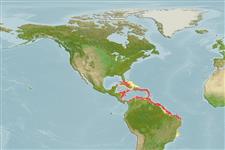Preferred temperature (Ref.
115969): 21.2 - 26.5, mean 24.8 (based on 38 cells).
Phylogenetic diversity index (Ref.
82804): PD
50 = 0.5000 [Uniqueness, from 0.5 = low to 2.0 = high].
Bayesian length-weight: a=0.01479 (0.01295 - 0.01690), b=2.97 (2.94 - 3.00), in cm Total Length, based on LWR estimates for this species (Ref.
93245).
Trophic level (Ref.
69278): 3.6 ±0.6 se; based on diet studies.
Resilienza (Ref.
120179): Basso, tempo minimo di raddoppiamento della popolazione 4.5 - 14 anni (K=0.09-0.12; tm=5.5; tmax=18; Fec=2,693,173 (mean)).
Prior r = 0.48, 95% CL = 0.32 - 0.72, Based on 3 data-limited stock assessments.
Fishing Vulnerability (Ref.
59153): High vulnerability (60 of 100).
Climate Vulnerability (Ref.
125649): High to very high vulnerability (75 of 100).
